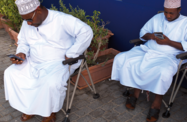Efforts to expand the reach of broadband internet to encompass the entire country are expected to help Oman meet the needs of its growing economy, but the sheer size of the country and the scope of laying out necessary infrastructure present significant challenges.
On June 9, Ahmed Bin Mohammed Al Futaisi, the minister of transport and communications, set out the government’s mid-term aims regarding broadband coverage, saying that more than 60% of Oman should have access to broadband services by 2017.
Under the plan outlined by the minister, government departments, universities, industrial estates and commercial complexes will be provided with broadband download speeds of 1 gigabyte per second (GB/s). Some 80% of built-up areas will see download speeds of between 20 megabytes per second (MB/s) and 100 MB/s. Other areas will have download speeds of between 5 MB/s and 20 MB/s, while remote regions of the country will have access rates of 3 MB/s to 5MB/s.
This plan would serve as a road map, the minister said, one that would point the way towards supporting the competitive capacity of the economy and enhancing the quality of telecoms services to all Omanis.
To this end, the Telecommunications Regulatory Authority (TRA) announced in mid-June it will be working with Oman’s two mobile phone service providers to extend coverage to rural and remote areas, unveiling a plan to bring phone links to more than 150 villages by the end of 2012. The programme calls for the two operators – Omantel and Nawras – to establish 120 base stations to serve remote communities, with work set to commence in the third quarter of this year.
Amer Bin Awadh Al Rawas, the CEO of Omantel, said that while the new operating areas were not economically viable, the scheme was in line with both the company’s and the government’s longer-term objectives for the communications sector.
“In addition to providing telecoms services in areas covered by this initiative, the overall penetration of ICT services in the Sultanate will also increase, supporting the government’s efforts to shift to a digital society,” he said.
“Oman has a small population, widely spread over a land mass with interesting topography, which naturally makes it challenging to deliver services of all kinds, including communications,” Ross Cormack, the CEO of Nawras, told OBG. “There are still quite a number of small villages without utilities like telecoms and we, as operators, need to do our part to support the Information Technology Authority and TRA initiatives.”
While the programme will greatly extend mobile coverage and give more Omanis access to broadband through their handsets, Hamed Al Rawahi, the CEO of the TRA, said there will still be some regions without access to such services.
“This is an issue that the TRA is currently working on through implementing field surveys in the remaining areas. Upon specifying such areas, the TRA will set the plans to accomplish the coverage of the remaining villages, in coordination with other government authorities,” he said.
Indeed, the sheer size of the country is one factor restricting higher levels of net usage. Oman has a landmass of around 310,000 sq km, dwarfing the 11,500 sq km of Qatar and the 77,000 sq km of the UAE. Access to mobile phone services, the platform of choice for most Omani internet users, varies across the country. In some of the more remote regions, access is all but non-existent, as the necessary infrastructure has not been put in place due to the high cost and low returns.
According to data from the TRA, the Sultanate had 1.8m internet subscribers as of mid-June 2011, with the majority of those accessing their accounts through handheld sets. The TRA’s figures are somewhat higher than those provided by the International Telecommunications Union (ITU), the UN agency that deals with information and communications technology (ICT) issues, which put Oman’s internet user numbers at 1.74m at the beginning of 2012, giving a penetration rate of 57.5% compared to the almost 60% reported by the TRA. Either way, the penetration rates are well below those of most of Oman’s regional neighbours, such as Qatar with 81% or the UAE at 69%.
Though much of Oman’s economic activity is centred around a few hubs, including the urbanised and industrialised areas such as Muscat, Sohar, Salalah and Sur, the policy of diversifying and expanding the Sultanate’s economy means that more than just the coastal cities will need access to high-quality ICT services. By providing broadband throughout the country, Oman will be able to bring remote communities much closer to the mainstream of the economy and to provide greater social and economic opportunities.

